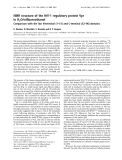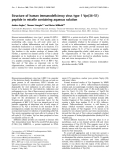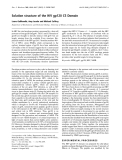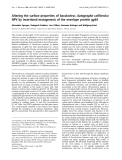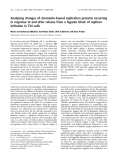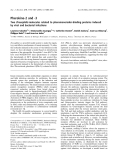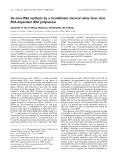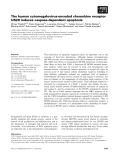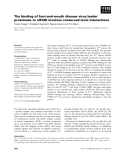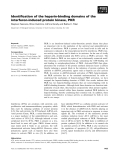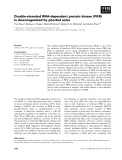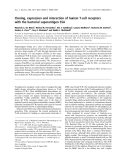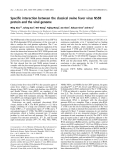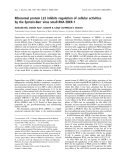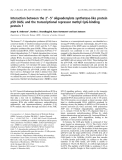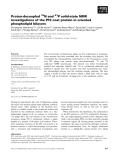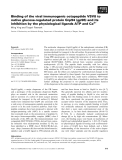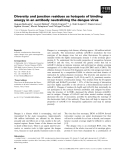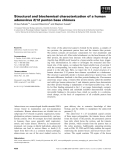
Viral proteins
-
The human immunodeficiency virus type 1, HIV-1, genome encodes a highly conserved regulatory gene product, Vpr (96 amino acids), which is incorporated into virions in quantities equivalent to those of the viral Gag protein. In infected cells, Vpr is believed to function during the early stages of HIV-1 replication (such as transcription of the proviral genome and migration of preintegration nuclear complex), blocks cells in G2 phase and triggers apoptosis.
 10p
10p  system191
system191
 01-06-2013
01-06-2013
 46
46
 4
4
 Download
Download
-
Human immunodeficiency virus type 1 protein R (HIV-1 Vpr) promotes nuclear entry of viral nucleic acids in nondividing cells, causes G2 cell cycle arrest and is involved in cellular differentiation and cell death. Vpr subcellular localization is as variable as its functions. It is known, that consistent with its role in nuclear transport, Vpr localizes to the nuclear envelope of human cells. Further, a reported ion channel activity of Vpr is clearly dependent on its localization in or at membranes.
 6p
6p  system191
system191
 01-06-2013
01-06-2013
 39
39
 4
4
 Download
Download
-
Hypoxia interrupts the initiation of simian virus 40 (SV40) replication in vivo at a stage situated before unwinding of the origin region. After re-oxygenation, unwinding followed by a synchronous round of viral replication takes place. To further characterize the hypoxia-induced inhibition of unwinding, we analysed the binding of several replication proteins to the viral minichromosome before and after re-oxygenation.
 11p
11p  research12
research12
 01-06-2013
01-06-2013
 42
42
 4
4
 Download
Download
-
InHIV the viral envelope protein is processed by a host cell protease toformgp120andgp41.TheC1andC5domainsof gp120 are thought to directly interact with gp41 but are largely missing from the available X-ray structure. Bio-physical studies of theHIVgp120C5 domain (residues 489– 511 of HIV-1 strain HXB2), which corresponds to the carboxy terminal region of gp120, have been undertaken.
 8p
8p  research12
research12
 29-04-2013
29-04-2013
 44
44
 4
4
 Download
Download
-
The envelope protein gp64 of the baculovirusAutographa californicanuclear polyhedrosis virus is essential for viral entry into insect cells, as the glycoprotein bothmediates pH-dependentmembrane fusionandbinds tohost cell receptors. Surface modification of baculovirus particles by genetic engineering of gp64 has been demonstrated by various strategies and thus has become an important and powerful tool in molecular biology.
 10p
10p  research12
research12
 23-04-2013
23-04-2013
 28
28
 2
2
 Download
Download
-
It was shown previously [Riedinger, H. J., van Betteraey-Nikoleit, M & Probst, H. (2002)Eur. J. Biochem.269, 2383–2393] that initiation ofin vivo SV40 DNA replication is reversibly suppressed by hypoxia in a state where viral minichromosomes exhibit a nearly complete set of repli-cation proteins. Reoxygenation triggers fast completion and post-translational modifications.
 11p
11p  tumor12
tumor12
 20-04-2013
20-04-2013
 31
31
 2
2
 Download
Download
-
Drosophilais a powerful model system to study the regula-tory and effector mechanisms of innate immunity. To iden-tify molecules induced in the course of viral infection in this insect, we have developed a model based on intrathoracic injection of the picorna-like DrosophilaCvirus(DCV).We have used MALDI-TOF mass spectrometry to compare the hemolymph of DCV infected flies and control flies. By contrast with the strong humoral response triggered by injectionof bacteriaor fungal spores, we have identifiedonly one molecule induced in the hemolymph of virus infected flies....
 10p
10p  tumor12
tumor12
 20-04-2013
20-04-2013
 30
30
 3
3
 Download
Download
-
Classical swine fever virus nonstructural protein 5B (NS5B) encodes an RNA-dependent RNA polymerase, a key enzyme of the viral replication complex. To better under-stand the initiation of viral RNA synthesis and to establish anin vitroreplication system, a recombinant NS5B protein, lacking the C-terminal 24-amino acid hydrophobic domain, was expressed inEscherichia coli.
 10p
10p  fptmusic
fptmusic
 12-04-2013
12-04-2013
 47
47
 4
4
 Download
Download
-
Viral subversion of apoptosis regulation plays an important role in the outcome of host⁄virus interactions. Although human cytomegalovirus (HCMV) encodes several immediate early (IE) antiapoptotic proteins (IE1, IE2, vMIA and vICA), no proapoptotic HCMV protein has yet been iden-tified. Here we show that US28, a functional IE HCMV-encoded chemo-kine receptor, which may be involved in both viral dissemination and immune evasion, constitutively induces apoptosis in several cell types.
 15p
15p  fptmusic
fptmusic
 11-04-2013
11-04-2013
 40
40
 2
2
 Download
Download
-
The leader proteinase (L pro ) of foot-and-mouth disease virus (FMDV) ini-tially cleaves itself from the polyprotein. Subsequently, L pro cleaves the host proteins eukaryotic initiation factor (eIF) 4GI and 4GII. This prevents protein synthesis from capped cellular mRNAs; the viral RNA is still trans-lated, initiating from an internal ribosome entry site. L pro cleaves eIF4GI between residues G674 and R675. We showed previously, however, that L pro binds to residues 640–669 of eIF4GI.
 10p
10p  awards
awards
 06-04-2013
06-04-2013
 39
39
 4
4
 Download
Download
-
PKR is an interferon-induced serine-threonine protein kinase that plays an important role in the mediation of the antiviral and antiproliferative actions of interferons. PKR is present at low basal levels in cells and its expression is induced at the transcriptional level by interferons. PKR’s kin-ase activity stays latent until it binds to its activator. In the case of virally infected cells, double-stranded (ds) RNA serves as PKR’s activator.
 15p
15p  awards
awards
 06-04-2013
06-04-2013
 33
33
 3
3
 Download
Download
-
The double-stranded RNA-dependent protein kinase (PKR) is one of the key mediators of interferon (IFN) action against certain viruses. PKR also plays an important role in signal transduction and immunomodulation. Understanding the regulation of PKR activity is important for the use of PKR as a tool to discover and develop novel therapeutics for viral infec-tions, cancer and immune dysfunction.
 0p
0p  awards
awards
 06-04-2013
06-04-2013
 28
28
 2
2
 Download
Download
-
Superantigens (SAgs) are a class of disease-causing and immunostimulatory proteins of bacterial or viral origin that activate a large number of T-cells through interaction with the Vbdomain of T-cell receptors (TCRs). In this study, recombinant TCRbchains were constructed with human variable domains Vb5.2, Vb1and Vb2.1, expressed as inclusion bodies, refolded and purified. The Streptococcus pyogenesSAg SSA-1 was cloned and expressed as a soluble periplasmicprotein. SSA-1wasobtainedbothas amonomer and a dimer that has an intermolecular disulfide bond. ...
 9p
9p  awards
awards
 05-04-2013
05-04-2013
 39
39
 5
5
 Download
Download
-
TheNS5Bproteinof the classical swine fever virus (CSFV) is the RNA-dependent RNA polymerase of the virus and is able to catalyze the viral genome replication. The 3¢ un-translated region is most likely involved in regulation of the Pestivirusgenome replication. However, little is known about the interaction between the CSFV NS5B protein and the viral genome.We used different RNA templates derived fromthe plus-strand viral genome, or theminus-strand viral genome and the CSFV NS5B protein obtained from the Escherichia coliexpression system to address this problem....
 9p
9p  awards
awards
 05-04-2013
05-04-2013
 47
47
 5
5
 Download
Download
-
Epstein–Barr virus (EBV) is a potent mitogenic and anti-apoptotic agent for B lymphocytes and is associated with several different types of human tumour. The abundantly expressed small viral RNA, EBER-1, binds to the growth inhibitory and pro-apoptotic protein kinase R (PKR) and blocks activation of the latter by double-stranded RNA. Recent evidence has suggested that expression of EBER-1 alone in EBV-negative B cells promotes a tumorigenic phe-notype and that this may be related to inhibition of the pro-apoptotic effects of PKR....
 11p
11p  dell39
dell39
 03-04-2013
03-04-2013
 44
44
 4
4
 Download
Download
-
The human 2¢)5¢ oligoadenylate synthetases (OAS) form a conserved family of interferon-induced proteins consisting of four genes:OAS1, OAS2, OAS3and the 2¢)5¢ oligo-adenylate synthetase-like gene (OASL). When activated by double-strandedRNA,OAS1–3polymerizeATP into2¢)5¢-linkedoligoadenylates; 2¢)5¢-linkedoligoadenylates, in turn, activate a latent endoribonuclease that degrades viral and cellular RNAs. In contrast, while the p59 OASLprotein is highlyhomologous to theOAS family (45%identity), its 350 amino acid N-terminal domain lacks 2¢)5¢ oligoadenylate synthetase activity. ...
 9p
9p  dell39
dell39
 03-04-2013
03-04-2013
 43
43
 5
5
 Download
Download
-
The coat proteins of filamentous phage are first synthesized as transmem-brane proteins and then assembled onto the extruding viral particles. We investigated the transmembrane conformation of the Pseudomonas aerugi-nosa Pf3 phage coat protein using proton-decoupled 15 N and 31 P solid-state NMR spectroscopy.
 12p
12p  dell39
dell39
 27-03-2013
27-03-2013
 42
42
 4
4
 Download
Download
-
The molecular chaperone Grp94 (gp96) of the endoplasmic reticulum (ER) lumen plays an essential role in the structural maturation and⁄or secretion of proteins destined for transport to the cell surface. Its proposed role in binding and transferring peptides for immune recognition is, however, controversial.
 10p
10p  dell39
dell39
 27-03-2013
27-03-2013
 41
41
 3
3
 Download
Download
-
Dengue is a re-emerging viral disease, affecting approx. 100 million individ-uals annually. The monoclonal antibody mAb4E11 neutralizes the four serotypes of the dengue virus, but not other flaviviruses. Its epitope is included within the highly immunogenic domain 3 of the envelope glyco-protein E.
 13p
13p  dell39
dell39
 27-03-2013
27-03-2013
 38
38
 3
3
 Download
Download
-
The vertex of the adenoviral capsid is formed by the penton, a complex of two proteins, the pentameric penton base and the trimeric fiber protein. The penton contains all necessary components for viral attachment and entry into the host cell. After initial attachment via the head domain of the fiber protein, the penton base interacts with cellular integrins through an Arg-Gly-Asp (RGD) motif located in a hypervariable surface loop, trigger-ing virus internalization.
 10p
10p  inspiron33
inspiron33
 25-03-2013
25-03-2013
 43
43
 6
6
 Download
Download
CHỦ ĐỀ BẠN MUỐN TÌM








